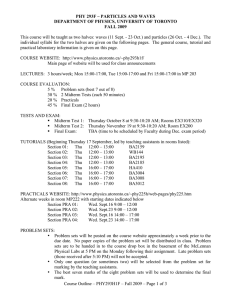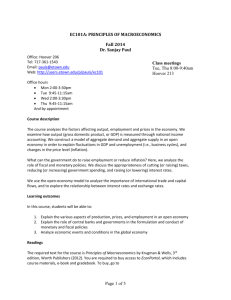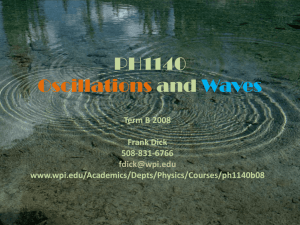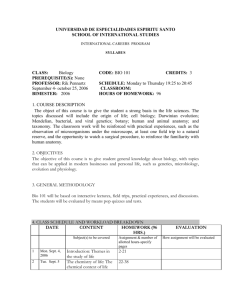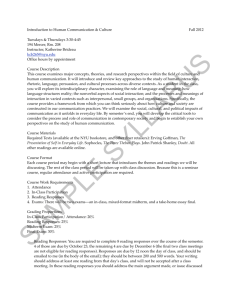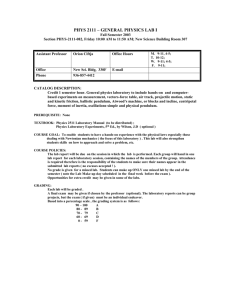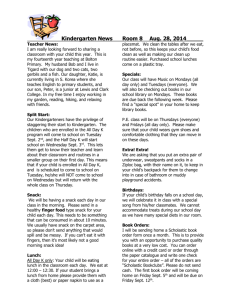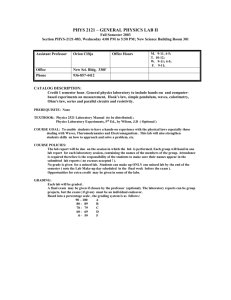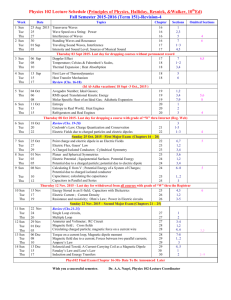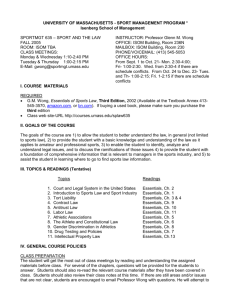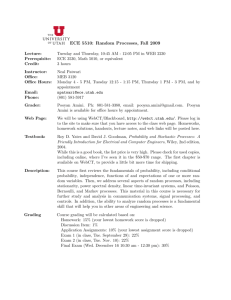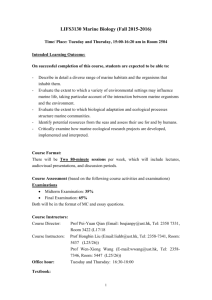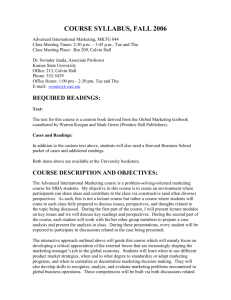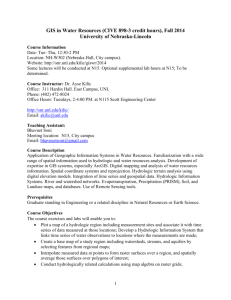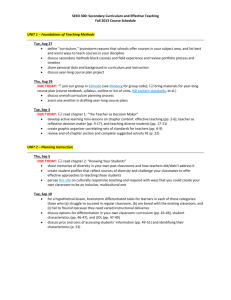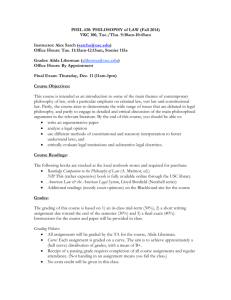Syllabus - University of Montana
advertisement
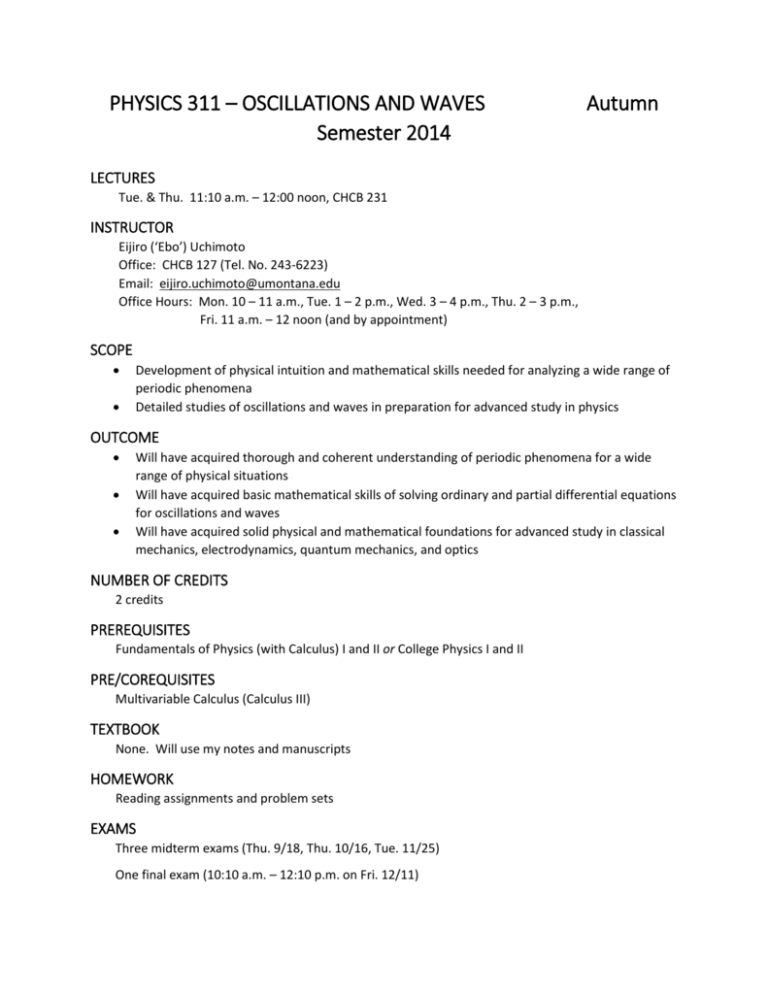
PHYSICS 311 – OSCILLATIONS AND WAVES Semester 2014 Autumn LECTURES Tue. & Thu. 11:10 a.m. – 12:00 noon, CHCB 231 INSTRUCTOR Eijiro (‘Ebo’) Uchimoto Office: CHCB 127 (Tel. No. 243-6223) Email: eijiro.uchimoto@umontana.edu Office Hours: Mon. 10 – 11 a.m., Tue. 1 – 2 p.m., Wed. 3 – 4 p.m., Thu. 2 – 3 p.m., Fri. 11 a.m. – 12 noon (and by appointment) SCOPE Development of physical intuition and mathematical skills needed for analyzing a wide range of periodic phenomena Detailed studies of oscillations and waves in preparation for advanced study in physics OUTCOME Will have acquired thorough and coherent understanding of periodic phenomena for a wide range of physical situations Will have acquired basic mathematical skills of solving ordinary and partial differential equations for oscillations and waves Will have acquired solid physical and mathematical foundations for advanced study in classical mechanics, electrodynamics, quantum mechanics, and optics NUMBER OF CREDITS 2 credits PREREQUISITES Fundamentals of Physics (with Calculus) I and II or College Physics I and II PRE/COREQUISITES Multivariable Calculus (Calculus III) TEXTBOOK None. Will use my notes and manuscripts HOMEWORK Reading assignments and problem sets EXAMS Three midterm exams (Thu. 9/18, Thu. 10/16, Tue. 11/25) One final exam (10:10 a.m. – 12:10 p.m. on Fri. 12/11) COURSE GUIDELINES AND POLICIES Student Conduct Code The Student Conduct Code at the University of Montana embodies and promotes honesty, integrity, accountability, rights, and responsibilities associated with constructive citizenship in our academic community. This Code describes expected standards of behavior for all students, including academic conduct and general conduct, and it outlines students' rights, responsibilities, and the campus processes for adjudicating alleged violations. Full student conduct code. http://www.umt.edu/vpsa/policies/student_conduct.php Course Withdrawal Students may use Cyberbear to drop courses through the first 15 instructional days of the semester. Beginning the 16th instructional day of the semester through the 45th instructional day, students use paper forms to drop, add and make changes of section, grading option or credit. PHSX 311 may not be taken as credit/no-credit. Disability Modifications The University of Montana assures equal access to instruction through collaboration between students with disabilities, instructors, and Disability Services for Students. If you think you may have a disability adversely affecting your academic performance, and you have not already registered with Disability Services, please contact Disability Services in Lommasson Center 154 or call 406.243.2243. I will work with you and Disability Services to provide an appropriate modification. Grading Policy Your grade will be based on the following: Problem sets: Midterm exams: Final exam: 25% 45% (15% each) 30% Typical cutoffs for the final course grade: A-/B+ B-/C+ C-/D+ D-/F 83% 72% 58% 45% TENTATIVE COURSE OUTLINE Date Week 1: Aug 26, 28 Topics Introduction Simple harmonic motion (SHM) Complex numbers Week 2: Sept 2, 4 More on SHM Linear ordinary equations (ODE’s) with constant coefficients Week 3: Sept 9, 11 Damped oscillators Underdamped, critically damped and overdamped cases Q value Week 4: Sept 16, 18 Forced oscillators EXAM #1 Week 5: Sept 23, 25 More on forced oscillators Non-homogeneous linear ODE’s Week 6: Sept 30, Oct 2 Coupled oscillators Normal modes Week 7: Oct 7, 9 Transverse waves on a string 1-D wave equation Week 8: Oct 14, 16 Solving the wave equation EXAM #2 Week 9: Oct 21, 23 2-D and 3-D wave equations Superposition principle, interference Week 10: Oct 28, 30 Phase and group velocities Energy and momentum transport associate with wave propagation Week 11: Nov 6 Electromagnetic waves Week 12: Nov 13 More on electromagnetic waves Week 13: Nov 18, 20 Fourier series and Fourier transform Laplace transform Week 14: Nov 25 EXAM #3 Week 15: Dec 2, 4 Quantum mechanics Review Week 16: Dec 12 FINAL EXAM
